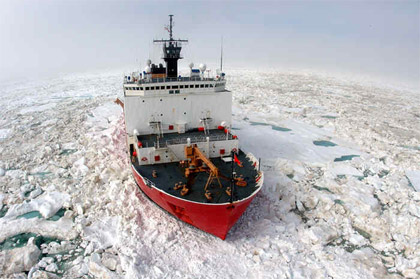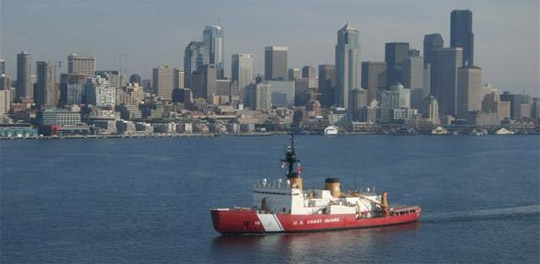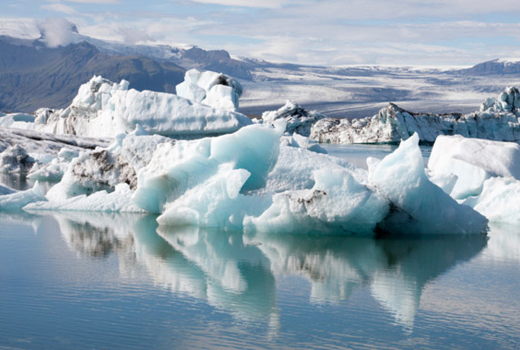The Arctic is Opening but the U.S.A. is Not Prepared
Environmentalists have talked about it for decades. Scientists have predicted it for awhile now. The U.S. Navy has been warning that we should prepare for it. Now even business is banking on it: Royal Dutch Shell Oil hopes to begin exploratory oil drilling in the Arctic Ocean. Shippers are already exploiting the shorter route “over the top.” So it’s no surprise to hear the Aug. 27, 2012, report from the National Snow and Ice Data Center that Arctic Ocean ice diminished to a record low extent this summer. (See the New York Times article.) The Arctic is opening and our nation is not prepared. An analogy would be the City of Buffalo, with its annual 94-inch snowfall, having one and one-half snow plows.
Less ice in summer opens the Arctic to more oil drilling, fishing, mining and research. It offers strategically significant shortened shipping routes between the Atlantic and Pacific Oceans. It raises the likelihood of territorial disputes among nations bordering the Arctic. Less ice in summer, however, doesn’t mean no ice – certainly not in the frigid sunless winter. The Arctic remains a harsh and dangerous environment where ships get trapped, equipment breaks, and people get hurt. It is also remote with few nearby ports, few airfields with specially equipped aircraft and trained, experienced crews and few icebreakers. Last December 2011, for example, the Coast Guard’s only operating Arctic icebreaker, Healy, had to escort a Russian-flagged tanker on an emergency fuel run to Nome, Alaska, where storms prevented a fuel shipment in the fall.
Increasing ship traffic in the Arctic increases the need to conduct search and rescue missions, to respond to emergencies involving people and the environment and to protect and police 1,000 miles of U.S. coastline, longer than from Maine to South Carolina. The situation also calls for increasing our research capacities to learn what we need to know about how changing Arctic conditions will affect its valuable ecosystem and the rest of the planet’s climate.
At present, the Coast Guard has only one operating icebreaker, Healy, with medium-strength icebreaking capacity. It has two other more heavy-duty icebreakers, Polar Star and Polar Sea, but they were built in the 1970s, have exceeded their expected 30-year service lives and currently are nonoperational. Polar Star is being fixed-up as a stop gap as designs for a new ship are being started – a process that will take at least 10 years if history serves correctly.
For decades, scientific, military and governmental organizations ranging from the National Academy of Sciences (2011) to the Center for Naval Analyses (2007) to the Congressional Research Service (2012) have made the case for enhancing capabilities in the Arctic. But sticker shock over the enormous costs of operating there has led to “I can’t afford it; you do it” and “kick the can down the road” mentalities. This deferred capitalization status makes it an even tougher problem to solve.

Photo Credit: U.S. Coast Guard | U.S. Coast Guard Cutter HEALY (WAGB-20)
During the Cold War, when the Arctic Ocean was a critical submarine battleground, the Navy had icebreaking responsibilities and maintained robust polar research funding. But it transferred its icebreaking assets to the Coast Guard during the Nixon Administration and nearly zeroed-out its Arctic research budget after the Berlin Wall fell.
In 1990, the Bush Administration and Congress authorized the Navy to build a new icebreaker for $560 million, but Congress didn’t allocate funds. The Navy, Coast Guard and National Science Foundation all desired ice-capable ships, but Coast Guard budgets never were allotted sufficient funds to take on the entire cost of building one. Navy funds paid for Healy, which was delivered in 1999, but to save money, it was built with less icebreaking capability and designed primarily to support scientific research for the National Science Foundation (NSF). The U.S. relied on ice-breaking services bought from the Russians, Canadians or Germans, who had icebreakers, but those nations have their own uses for those ships.
In the Antarctic polar region, the U.S. operates one smaller ice-capable research ship, the Nathaniel B. Palmer, leased by NSF. It can break ice only up to 3-feet thick, which is not sufficient to perform resupply missions to McMurdo Station, the U.S. Antarctic research station. In the late 2000s, NSF rented Sweden’s icebreaker Oden at a cost of about $10 million a year to do the job, but in 2011 Sweden decided the vessel was needed at home. The U.S. had to scurry to charter a Russian icebreaker in time or cease operations at the station.
Meanwhile, with the U.S. scientific community seeking more access to the Far North, NSF had designed two new ice-capable research vessels, one to be stationed on each U.S. coast (since it costs about $1 million to steam from one end of the Arctic to the other). But once more, the costs seemed too high. As a compromise, officials decided the new ships would not be additional but would replace older vessels in the U.S. research fleet that had to be retired. Funding for the second ship of the class subsequently dried up. Next year when a new ice-capable research vessel, Sikuliaq, comes on line, the U.S will have as many icebreaking ships as the nongovernmental (NGO) organization Greenpeace.
It always comes as a surprise to facilities planners and advocates, but it’s an unavoidable fact that ships working in polar waters cost several times what their temperate-clime counterparts do. They have to be built bigger and stronger. There are no port facilities on the U.S. and Canadian side so ships have to be designed to take everything they might need with them and stay out longer. Their requirements to handle higher seas and operate in or around the ice bring a whole set of very expensive features: stronger hulls, more power, more fuel in case of becoming trapped, environmental rules that require double hulls, anti-icing features and so on. Being large means they burn more fuel, especially when breaking ice, and need larger crews with extra skills, thus adding to operation and maintenance costs that exacerbate officials’ reluctance to fund them.
Other Arctic nations, however, take a much different view. Russia has 25 icebreakers, according to a Congressional Research Service report. Finland and Sweden have seven icebreakers each. Canada has six. The Russians see the opening of the Arctic as an opportunity for more income and have recently unveiled plans to expand their Arctic infrastructure, which is already the largest in the world. Denmark is following suit; it is focusing on oil and gas opportunities while Canada is enhancing its military and research capacity. Even the Chinese have built an icebreaking research vessel, which is now operating in Arctic waters.
Admiral Robert J. Papp, Commandant of the U.S. Coast Guard, says the Coast Guard needs two more medium-strength icebreakers and two more heavy-duty ones (assuming the Polar Star can be repaired and returned to operation). The Coast Guard’s fiscal 2013 budget calls for $8 million to study building one, and its five-year plan calls for $852 million, not yet funded, to build it “within a decade.”
The new reports on diminishing Arctic ice should compel us to act on the recommendations of a decade of studies. We recommend the U.S.:
- Accede to the United Nations Convention on the Law of the Sea, which will allow the U.S. to protect its sovereign interests in the Arctic and elsewhere;
- Increase polar research funding, both civilian and military;
- Build a second Arctic-capable research vessel to cover the Eastern Arctic and
- Ramp up Navy, and especially U.S. Coast Guard, capitalization to build ice-capable ships and aircraft.
The price tag won’t be cheap, but it’s the ante to play at the table. The Arctic’s icy covering is coming off, and the action there will be heating up imminently. Right now, the U.S. isn’t prepared for it.

Photo Credit: U.S. Coast Guard | U.S. Coast Guard Cutter POLAR STAR (WAGB-10)





























